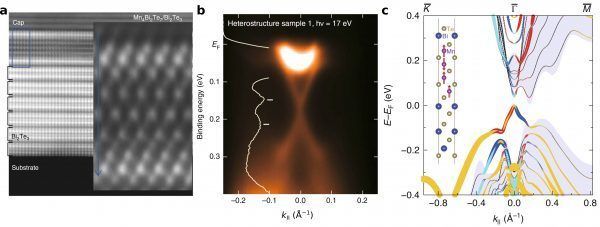Fabrication of a novel magnetic topological heterostructure and temperature evolution of its massive Dirac cone
Using Angle Resolved Photoemission Spectroscopy (ARPES) and ab initio calculations, Hirahara et al. have studied the molecular beam epitaxy grown heterostructure Mn4Bi2Te7/Bi2Te3 achieved by self-organization of the Mn and Te adatoms co-deposited on Bi2Te3. The authors reveal a sizable Dirac point gap and study its temperature evolution.
Although the interfaces between trivial magnetic and topological nonmagnetic insulators have recently attracted a great deal of attention, no photoemission evidence of the Dirac point gap opening in the topological interface state has been reported. To bridge this gap, the authors have synthesized a novel magnetic topological heterostructure with a built-in interface achieved via self-organization of the MnTe film inside of the Bi2Te3 surface quintuple layer block (e.g., Te−Bi−Se−[MnTe]−Bi−Te), where the magnetic film has adopted its bulk-like (NiAs-like) structure, see Figure (a). The resulting structure can be written as Mn4Bi2Te7/Bi2Te3. Strikingly, the realization of this scenario leads to a unique situation when the heterostructure’s magnetic part is based on a material that intrinsically does not show Van der Waals bonding (MnTe), but turns out to be Van der Waals coupled to a topological insulator substrate.

Figure: (a) Scanning transmission electron microscope image of the Mn4Bi2Te7/Bi2Te3 heterostructure measured at room temperature. The inset shows the atomically-resolved image. (b) Band dispersion of the heterostructure sample measured with ARPES. The white line shows the energy distribution curve at the Γ-point. (c) Calculated band dispersion of the Mn4Bi2Te7/Bi2Te3 heterostructure. The inset shows the predicted magnetic structure.
ARPES measurements of Mn4Bi2Te7/Bi2Te3 reveal a massive Dirac cone with a gap of 40-75 meV at 16 K (Figure b). The system showed long-range magnetic order with a critical temperature of about 20 K. Ab initio calculations predict a complicated magnetic configuration for Mn4Bi2Te7/Bi2Te3 combining both ferromagnetic and antiferromagnetic couplings between adjacent layers (Figure c, inset). Surface electronic structure calculations confirm the existence of the gapped Dirac cone for these crystal and magnetic structures (Figure c). Further, by tracing the temperature evolution, they find the Dirac point gap to gradually decrease with increasing temperature, with a transition from a massive to a massless Dirac cone occurring around 200–250 K. Thus, these results show for the first time that the Dirac point gap of the interface topological state of the magnetic topological heterostructure eventually closes, albeit at a temperature well above the magnetic critical temperature. Such findings open a new direction in studies of the magnetic insulator/topological insulator interfaces and restore their potential for the observation of the quantum anomalous Hall and topological magnetoelectric effects.



